Izzet Phoenix, Dredge, Bridgevine, KCI, Hogaak. All of these decks have some time atop the Modern metagame. Some are still there. That’s a lot of graveyard-based strategies to disrupt with your Modern sideboard.
When graveyard decks rise to power, people suddenly realize they have been neglecting that aspect of their sideboard. It can be easy to play the wrong cards, or the wrong number of cards. And here we are: graveyard decks are dominant.
Everyone defaults to playing four copies of Leyline of the Void. It’s a great card, and often most effective, but I don’t believe this line of thinking is correct as often as we think it is.
What Are Your Options?
Before we can get into why, let’s take a look at our options and what they do.
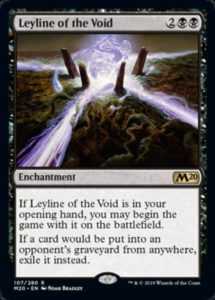
As I mentioned before, Leyline of the Void is the gold standard anti-graveyard card in Modern. When decks that abuse the graveyard become popular, this is the first place people look. Leyline checks a lot of boxes: free, powerful, and wins the game if it hangs around.
Honestly with a resume like that, the choice to max out on Leyline looks sensible. Two downsides come to mind. If you don’t start the game with Leyline in hand to play for free, the 2BB mana cost can be tough to pay at all, and usually comes way too late. Plus, as an enchantment, it will die to almost all the anti-hate answers your opponent brings in. Graveyard pilots know Leyline is coming, and they typically play four to six Disenchant-type effects.
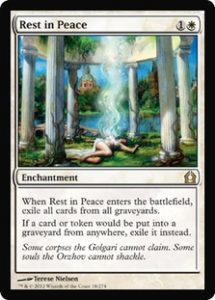
The usefulness of Rest in Peace is restricted by its color, but the power level is still quite high assuming that it comes down quickly. Two mana can be a steep cost given the speed of decks like Dredge, Hogaak, and Phoenix; but if these decks take some time to set up, Rest in Peace can be devastating.
Look to pair Rest in Peace with one-mana disruption to minimize the costs associated. Cards like Thoughtseize and Spell Pierce work well. Rest in Peace does suffer all of the same enchantment-related downsides as Leyline of the Void however, and it won’t surprise anyone.
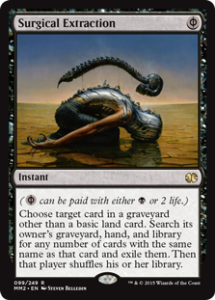
Our first non-permanent piece of hate, Surgical Extraction is at its best when your opponent needs a specific card to function. It has lost some effectiveness lately because the graveyard decks rely on engines more than they do individual cards. Indeed, Surgical Extraction has taken a back seat to the effects the exile the entire graveyard.
But Surgical plays well against some combo decks as well as the graveyard decks, making it a versatile sideboard choice. If you are playing a deck that can effectively get a key combo piece into the graveyard via something like a discard or counterspell, following up with Surgical can end the game—for example, against Ad Nauseam. More often than not, Surgical Extraction backed up with a clock will get the job done.
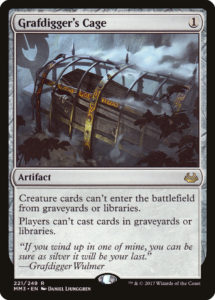
Grafdigger’s Cage is another piece of hate that plays double duty! Cage has seen less play lately, in favor of cards like Leyline of the Void given the speed of Hogaak. With Bridge from Below hitting the banned list and Neoform rising in popularity, expect to see more copies of this one floating around.
Don’t forget: Cage is good against the Collected Company and Chord of Calling decks, which provides some added utility. The downside is that you have to spend valuable early-game mana to get this on the table while it’s still relevant.
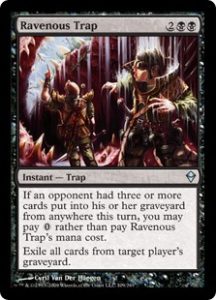
The strength of Ravenous Trap is that is hard to play around even when you know your opponent has it. Phoenix, Dredge, and Hogaak all need to put at least three cards in the graveyard on most turns of the game if they’re doing much of anything. Being able to respond to triggers from Bloodghast, Narcomoeba, and Arclight Phoenix—or removing the cards from your opponent’s graveyard so they can’t delve for Hogaak—means Ravenous Trap when timed correctly can be a beating.
Ravenous Trap is vulnerable to discard and counterspells, which makes it a bit sketchy at times to rely on it. Generally you’re safer from those things that removal for permanents, but a savvy opponent can sequence their discard spell to prevent you from casting it in response.
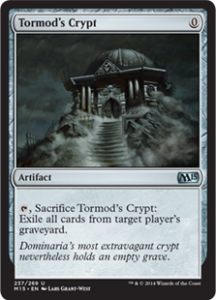
Similar to Ravenous Trap, Tormod’s Crypt provides a one-shot effect that hits the entire graveyard. As a bonus, it works without your opponent having to put three cards in their graveyard first. The downside, of course, is that it sits on board so your opponent can always see it coming.
I would look to Tormod’s Crypt in decks that want to play their cards early and also want them to be free, like Mono-Red Phoenix.
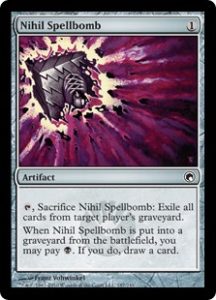
Nihil Spellbomb does basically the same thing as Tormod’s Crypt, but costs one mana. It has the bonus ability to pay a black mana when you sacrifice it to draw a card. You’ll frequently see some copies of this out of black midrange decks that may have some extra mana laying around should they not need to use any other interaction.
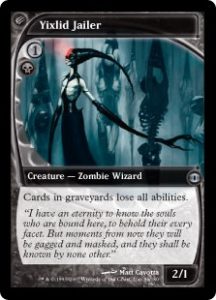
Finally we have Yixilid Jailer, the only hard graveyard hate attached to a body. This future-shifted 2/1 used to be the de facto graveyard hate until Leylines took over. Naturally decks like Finale of Devastation, which have easy access to any of the creatures in their deck, want a card like Jailer to tutor up. Decks that care about attacking also may start looking to the cheap beater to lock down the yard.
The downsides here are pretty clear. It’s restricted to being in a deck with black mana, and dies to just about everything.
Which Decks Want Which Cards?
Typically the trend has been: the worse your matchup against the graveyard decks are, the more likely you are to have high-impact answers like Leyline of the Void. But there are other spots where you want different answers.
Decks that see tons of cards, like Izzet Phoenix or Azorius Control, may have interest in some of the instant-speed options like Ravenous Trap or Surgical Extraction. While these cards may not be high-impact, high-velocity decks have the ability to dig when they need these answers and dig for other cards when they don’t.
Midrange decks, on the other hand, will usually want to mix up their hate. For example, if you’re playing Jund it is likely that you already have some soft hate in the main deck in the form of Scavenging Ooze. You will still see some Jund players sleeve up a set of Leyline of the Void, but it is also common to see a couple copies of Surgical Extraction, Nihil Spellbomb, and Grafdigger’s Cage to cover bases in multiple matchups.
Decks that are looking to apply pressure quickly will usually lean on the cheap or free options. Fast decks rarely have time to spend mana interacting with the opponent. So you can often expect to see things like Surgical Extraction, Tormod’s Crypt, and Ravenous Trap in this spots.
Decks with Snapcaster Mage or Kess, Dissident Mage that have access to their graveyard on a regular basis tend to lean toward spell-based interaction like Surgical Extraction. These flashback creatures give you two copies of the same effect for one sideboard card. You’ll likely not see any copies of Ravenous Trap though, because you can’t play it for free with flashback.
When Should You Avoid Leyline of the Void?
Leyline of the Void gets a lot worse when everyone knows it is coming. And yet, people reach for their copies whenever graveyard decks run rampart. But if the graveyard decks are good, why wouldn’t I want my Leylines?
Those familiar with fighting games know the concept of a mix-up. The name kind of explains the concept: do something that your opponent doesn’t expect you to do. Decks like Dredge and Hogaak have a very difficult time beating Leyline of the Void when it sits in play. Naturally, if your opponent thinks your deck will contain permanent-based hate, they will sideboard accordingly and bring in a bunch of ways to destroy enchantments. Many pilots of these decks will hedge and bring in small numbers of these cards even if they aren’t sure. Here is where the value of the mix-up comes in. If you recognize this during deck-building, you can eschew cards like Leyline of the Void for cards like Ravenous Trap and Surgical Extraction.
Aren’t these cards less powerful than Leyline of the Void? In many cases they are, but your opponent may not be ready to beat the cards that you have. From the Dredge/Hogaak player’s side of things, opening hands with something like Nature’s Claim look more attractive than normal. This is where the mix-up hits. Your opponent sideboarded in four to six Disenchant effects, but you don’t actually have any targets! So, while your cards may be less powerful than Leyline of the Void in a vacuum, they gain a lot of stock once your opponent shuffles in a stack of blanks before game two. This mix-up isn’t always going to be the correct play. But it should be something you think about when building your deck, especially when Leyline of the Void or other permanent-based hate cards are prevalent.
Hopefully this gave you a better understanding on how to configure the graveyard hate in your deck going forward. Until next time, thanks for reading!
Michael Rapp is a Boston-area grinder who started playing competitively in 2014. Loves Modern but plays everything. His favorite card is Thoughtseize has a soft spot for Tarmogoyf. GP Toronto 2019 Champion. Always happy to answer questions or just chat on Twitter or Facebook.

